Alvin and the Chipmunks Meet Frankenstein – 1999
“I read with ardour those works, so full of genius and discrimination, which modern inquirers have written on these subjects. I attended the lectures and cultivated the acquaintance of the men of science of the university…” — Mary Shelley, Frankenstein.
“Arms… two. Legs… two. Feet… none. Ah, now where did I put them?” — Dr Frankenstein, Alvin and the Chipmunks Meet Frankenstein
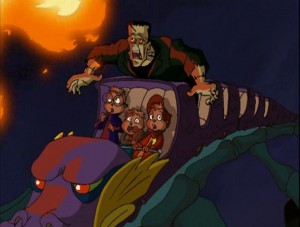
Full disclosure: this is the first Alvin and the Chipmunks vehicle I have ever watched all the way through. I’m sort of the wrong age for them. They were popular before my childhood, and were revived at a time in my teenage years when I was deeply uninterested in kid’s cartoons. I wasn’t impressed by their antics in this movie, but I have no idea whether that’s because the Chipmunks are generally not great, or just because this was a lifeless outing.
So I’m just going to look at this as a Frankenstein Movie. The Monster attacks a toy-shop in a little East European village, causing the villagers to form the traditional lynch mob and try to destroy it. They’re thwarted by Dr Frankenstein, in what was the funniest gag in the movie. He confronts the mob and demands to know whether they think he’s build a living creature out of dead bodies. The mob agrees that this is pretty unlikely, so disperses. Frankenstein disassembles the Monster for travel, and goes to hide out in an amusement park Frankenstein Castle in America.
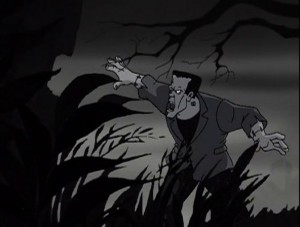
The Chipmunks are singing at the same amusement park. Their song is like a needle drilling into my skull. They go off to have some fun between performances but become lost, and are locked inside the amusement park at night. They contact their foster father Dave, who comes in search of them. As they wait, they stumble upon the Frankenstein Castle where Dr F is bringing the monster back. The Monster chases them around for a bit. Note that in the first scene, the Monster was attempting to steal a teddy bear, whereas one of the Chipmunks (Theodore, maybe? I don’t know) is also carrying a teddy.
Dave goes to the amusement park, where he narrowly avoids being drugged by Dr F. The Chipmunks escape from the Monster and go home to Dave, who refuses to believe the Monster story. Alvin is annoyed at this, but not keen to go back. Theodore notices that he’s left his teddy behind. There’s another musical number, even more obnoxious than the first one.
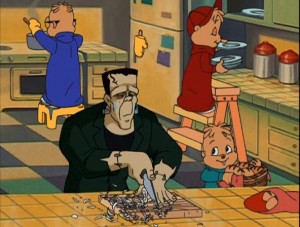
The Monster arrives at Dave’s house with Theodore’s teddy in his hand. He returns the toy, and Theodore realises that the creature is not evil. Dr Frankenstein goes looking for his creation, tracking him to Dave’s house. The Chipmunks hide the Monster from Dave. The Chipmunks have fun with their new friend. Some mild shenanigans ensue.
Frankenstein captures Alvin and experiments on him. At this point, much to my surprise, I start enjoying the movie. Frankenstein’s experiment has the effect of causing Alvin to transform from a dull 1990s cartoon into a wacky 1940s style cartoon character and Alvin runs amok at a film premiere. It’s really unexpected and quite charming. It’s almost like the writers ran out of clichés and had to fill out the third act with actual creativity. Simon (or is it Theodore) uses Frankenstein’s notebook to learn the antidote. Frankenstein gets into the premiere, 1940s animation style by disguising himself. Simon and Theodore get Alvin to drink the antidote and he returns to normal.

The Chipmunks go to perform again, but Frankenstein sets up a booby-trap for Alvin. The Monster throws Frankenstein into his own trap, but the audience wrongly believes that the Monster is attacking the Chipmunks. They form an angry mob, but Theodore convinces them not to attack. Frankenstein finds himself trapped in his disguise as Sammy Squirrel, doomed to be a theme park mascot forever. The Monster learns to talk and becomes a theme park guide. The end
It’s a crappy, straight-to-video movie featuring second-string cartoon characters, but what does it say about Frankenstein? Firstly, it uses what we will see is the standard children’s version of the Frankenstein metaphor: don’t judge people on their appearance. Just because someone looks scary, doesn’t mean that they are. It’s not a deep thought, but it’s true and it’s important none the less. It’s also true that just because someone seems nice that doesn’t mean that they are, but that’s less popular as a moral to children’s fiction.
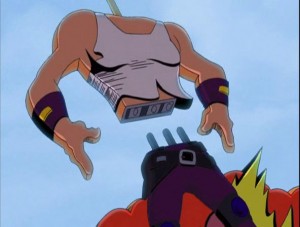
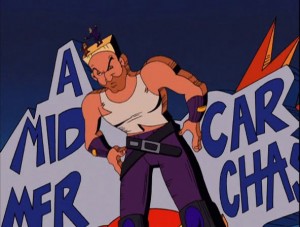
There’s also a little side story involving the entertainment politics within the amusement park. I assume this is aimed at the parents in the audience. The archetypes of the wannabe-actor and the cranky, spineless producer can’t mean much to most eight year olds. But in this subplot, we see another use of the Frankenstein metaphor to connect the Monster to the artificiality that is celebrity.
The Monster is shown to be modular, able to be pulled apart as easily as being put together. Early in the film, another modular body is shown – a huge advertising statue of action hero Bud Wiley, built in pieces. When Alvin goes berserk, he ends up on top of it along with the real Wiley (who, interestingly, is depicted with a flat-top hairdo). As the statue collapses so does Wiley’s bravado, and he is revealed to be a physical coward, unlike his heroic movie persona. Wiley the celebrity is an artificial being. Is this deliberate on the part of the writers? I don’t know. But it’s there, none the less.
Frankenstein is shown to be a cruel, sneaky, ratlike character, explicitly contrasted with the Chipmunk’s father figure, Dave. The Monster’s redemption comes after he turns (in a non-murderous manner) on his evil father, rejecting his cruelty in favour of the Chipmunk’s friendship. Yes, it’s silly and shallow in its presentation, but strangely, it means that this film returns to one of Mary Shelley’s original points, so often forgotten by filmmakers. Frankenstein isn’t necessarily evil for creating a monster, he’s evil for being a bad father to it.
What I love about the Frankenstein story is the depth and complexity of its central metaphor. If even Alvin and the Chipmunks Meet Frankenstein can’t drain all of the depth out of that metaphor, then what can?




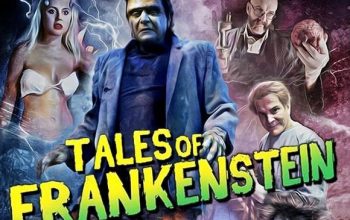
omg alvin looked and acted like Sonic the Hdgehog from AOSTH in this xD
Hey, yeah. He kind of did.
Without a doubt my#1 favorite chipmunks movie considering that i used to watch this movie alot when i was a kid. Add to the fact that it’s got Dr. Frankenstein and his monster in it makes it even more iconic and unforgettable.